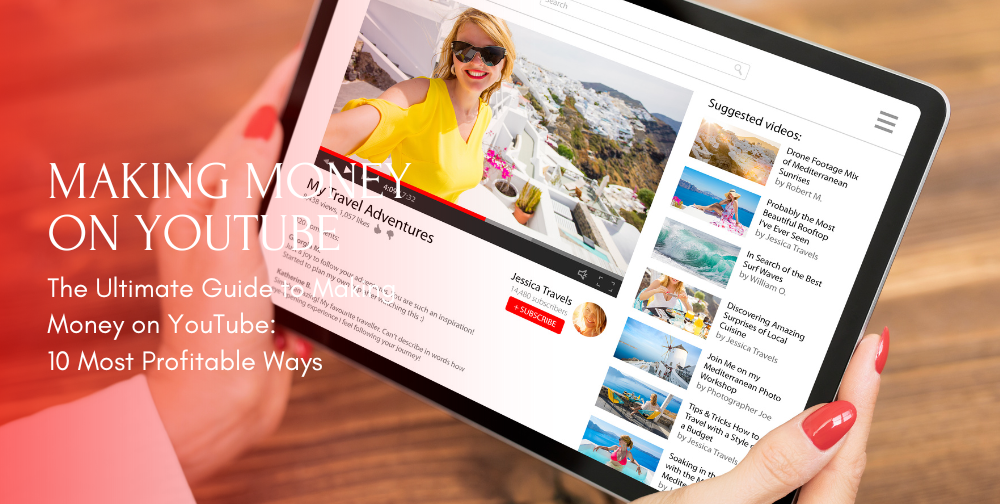YouTube has emerged as not just a platform for entertainment and information but also as a lucrative avenue for making money. With over a billion users consuming content daily and a vast array of creators building communities around diverse topics, YouTube offers unprecedented opportunities for earning revenue. This comprehensive guide explores the various ways to monetize YouTube, tools and platforms to aid in your journey, and a step-by-step approach to getting started.
What is YouTube?
YouTube, founded in 2005 and acquired by Google in 2006, is the world’s largest video-sharing platform. It allows users to upload, view, rate, share, and comment on videos. Over the years, YouTube has evolved into a global phenomenon, influencing trends, culture, and even politics. As of today, it boasts over 2 billion logged-in monthly users, with content available in over 100 countries and in 80 languages.
YouTube’s influence extends far beyond entertainment; it has become a powerful educational tool, a source of news, and a platform for businesses to reach their audience directly. From DIY tutorials to live streams of major events, YouTube offers a diverse range of content that caters to virtually every interest and niche.
Why Do You Need a YouTube Channel?
Creating a YouTube channel isn’t just about sharing videos; it’s about building a brand, establishing authority in your niche, and connecting with a global audience. Here are several reasons why having a YouTube channel can be beneficial:
Global Reach: YouTube allows you to reach a global audience, breaking down geographical barriers and enabling you to connect with people from different cultures and backgrounds.
Monetization Opportunities: YouTube offers multiple ways to monetize your content, allowing you to earn money from ads, channel memberships, merchandise, and more.
Build a Community: YouTube channels enable you to build a loyal community of subscribers who are interested in your content. This community can provide valuable feedback, support, and engagement.
Diversify Income Streams: Beyond ad revenue, YouTube channels can be monetized through sponsorships, affiliate marketing, selling digital products, and even crowdfunding.
Establish Authority: By consistently uploading high-quality content in your niche, you can establish yourself as an authority figure, gaining recognition and credibility.
Creative Outlet: YouTube provides a platform for creative expression, allowing you to share your passion, expertise, and unique perspective with the world.
What Makes YouTube Special?
YouTube’s uniqueness lies in its accessibility, reach, and diverse content ecosystem. Here are some key aspects that set YouTube apart:
Accessibility: Anyone can create a YouTube channel and start uploading videos with minimal barriers to entry. This democratization of content creation has empowered millions of creators worldwide.
Global Reach: With a vast and diverse user base, YouTube offers unparalleled reach, allowing creators to connect with audiences on a global scale.
Engagement: YouTube fosters high levels of engagement through likes, comments, shares, and subscriptions, creating a dynamic community around each channel.
Monetization Options: YouTube provides multiple avenues for creators to monetize their content, including advertising revenue, channel memberships, merchandise sales, and more.
Analytics and Tools: Creators have access to robust analytics and tools that provide insights into audience demographics, viewer behavior, and performance metrics, enabling them to optimize their content and grow their channel.
Integration with Google: As part of the Google ecosystem, YouTube benefits from Google’s advertising network and search engine, enhancing discoverability and revenue potential for creators.
The 10 Most Profitable Ways To Make Money With YouTube
Now, let’s delve into the ten most profitable ways to monetize your YouTube channel:
1) Ad Revenue (Google AdSense):
How It Works: Google AdSense is YouTube’s advertising platform that allows creators to earn money from ads displayed on their videos.
Earning Potential: Ad revenue is generated based on factors like video views, engagement, viewer demographics, and advertiser demand.
Requirements: You need to have at least 1,000 subscribers and 4,000 watch hours in the past 12 months to qualify for monetization.
Tips: Increase your ad revenue by optimizing video content, targeting high-paying keywords, and encouraging longer watch times.
2) Channel Memberships:
How It Works: Channel memberships allow viewers to subscribe to your channel for a monthly fee (typically $4.99) in exchange for perks like badges, emojis, and exclusive content.
Earning Potential: Membership revenue is recurring and can provide a stable income stream if you have a loyal subscriber base.
Requirements: You need at least 30,000 subscribers to be eligible for channel memberships.
Tips: Offer valuable perks to incentivize viewers to become paying members, such as behind-the-scenes content, Q&A sessions, or early access to videos.
3) Merchandise Shelf:
How It Works: The merchandise shelf allows eligible channels to showcase and sell their branded merchandise directly beneath their videos.
Earning Potential: You earn a commission on each sale made through the merchandise shelf.
Requirements: To use the merchandise shelf, you need to be based in a country where it’s available and have at least 10,000 subscribers.
Tips: Create appealing merchandise that resonates with your audience and promote it in your videos to maximize sales.
4) Sponsorships and Brand Deals:
How It Works: Brands pay creators to promote their products or services in their videos, either through dedicated sponsorships or product placements.
Earning Potential: Sponsorship earnings vary based on factors like your audience size, engagement rate, and niche.
Tips: Partner with brands that align with your channel’s values and audience interests to maintain authenticity and credibility.
5) Affiliate Marketing:
How It Works: Creators earn a commission by promoting products or services through affiliate links in their video descriptions or during content.
Earning Potential: Affiliate earnings depend on the conversion rate of your affiliate links and the commission structure set by the affiliate program.
Tips: Choose affiliate products relevant to your audience and disclose your affiliate relationships transparently to build trust.
6) Crowdfunding (Patreon, Ko-fi):
How It Works: Platforms like Patreon and Ko-fi allow fans to support creators through monthly subscriptions or one-time donations in exchange for exclusive perks.
Earning Potential: Crowdfunding can provide supplementary income beyond traditional monetization methods.
Tips: Offer unique rewards for supporters, such as personalized shout-outs, merchandise, or exclusive content, to encourage contributions.
7) Digital Products (E-books, Online Courses):
How It Works: Creators can sell digital products such as e-books, online courses, or digital downloads related to their niche.
Earning Potential: Selling digital products leverages your expertise and can generate passive income once created.
Tips: Identify pain points or interests within your audience and create valuable digital products that address those needs effectively.
8) Fan Funding (Super Chat, Super Stickers):
How It Works: Viewers can purchase Super Chats or Super Stickers during live streams to highlight their messages and support creators.
Earning Potential: Super Chat and Super Sticker earnings increase engagement during live streams and provide instant monetary support.
Tips: Interact with viewers who send Super Chats or Stickers to show appreciation and foster a sense of community.
9) YouTube Premium Revenue:
How It Works: Creators earn a share of the revenue generated from YouTube Premium subscribers who watch their content without ads.
Earning Potential: YouTube Premium revenue is calculated based on watch time from Premium subscribers consuming your content.
Tips: Focus on creating engaging content that encourages viewers to watch for longer durations, maximizing your YouTube Premium revenue.
10) License Your Content:
How It Works: License your original videos or footage to media outlets, production companies, or other creators for a fee.
Earning Potential: Licensing fees vary depending on the usage rights and demand for your content.
Tips: Protect your intellectual property rights and negotiate licensing agreements that ensure fair compensation for your content.
Platforms and Tools to Help You Make Money With YouTube
To effectively monetize your YouTube channel, consider leveraging the following platforms and tools:
Google AdSense: Manage and optimize ad placements on your videos to maximize ad revenue.
YouTube Analytics: Gain insights into viewer demographics, watch time, and revenue performance to optimize your content strategy.
YouTube Studio: Manage your channel, upload videos, and track performance metrics from a centralized dashboard.
Social Media Platforms: Promote your YouTube channel and content on platforms like Instagram, Facebook, and Twitter to expand your audience reach.
E-commerce Platforms: Use platforms like Shopify or Teespring to create and sell branded merchandise through your YouTube channel.
Affiliate Networks: Join affiliate programs such as Amazon Associates or ClickBank to monetize product recommendations in your videos.
Patreon and Ko-fi: Set up membership tiers or accept donations from fans who want to support your channel and access exclusive content.
Video Editing Software: Use tools like Adobe Premiere Pro, Final Cut Pro, or DaVinci Resolve to edit and enhance your videos for professional quality.
SEO Tools: Use tools like TubeBuddy or VidIQ to optimize video titles, descriptions, and tags for better search visibility on YouTube.
Email Marketing Platforms: Build an email list of subscribers and viewers to promote new content, merchandise, or digital products.
Step-by-Step Guide: How to Make Money on YouTube
Now, let’s walk through the steps to effectively monetize your YouTube channel:
Step 1: Define Your Niche and Audience
- Identify a niche that you are passionate about and have expertise in.
- Research your target audience’s interests, preferences, and pain points to create content that resonates with them.
Step 2: Create High-Quality Content
- Produce engaging, informative, and high-quality videos that provide value to your audience.
- Use a combination of storytelling, visuals, and editing techniques to enhance viewer engagement.
Step 3: Optimize Your Videos for Search
- Conduct keyword research using tools like Google Keyword Planner or TubeBuddy to identify relevant keywords for your videos.
- Optimize video titles, descriptions, tags, and thumbnails to improve search visibility and attract organic traffic.
Step 4: Build and Engage Your Audience
- Encourage viewers to subscribe to your channel, like, comment, and share your videos.
- Respond to viewer comments and feedback to foster a sense of community and loyalty.
Step 5: Meet Monetization Requirements
- Achieve YouTube’s monetization thresholds of 1,000 subscribers and 4,000 watch hours in the past 12 months to qualify for ad revenue.
- Explore additional monetization options such as channel memberships, merchandise shelf, and affiliate marketing as your channel grows.
Step 6: Enable Monetization on Your Channel
- Sign up for Google AdSense and link it to your YouTube channel to start earning ad revenue from eligible videos.
- Enable channel memberships and merchandise shelf once you meet the respective eligibility criteria.
Step 7: Diversify Your Revenue Streams
- Explore sponsorships, affiliate marketing, digital products, and crowdfunding to diversify your income sources and reduce reliance on ad revenue alone.
Step 8: Analyze Performance and Optimize
- Use YouTube Analytics to monitor video performance, audience demographics, and revenue metrics.
- Identify trends, strengths, and areas for improvement to refine your content strategy and increase monetization potential.
Step 9: Promote Your Channel and Content
- Share your videos on social media platforms, forums, and communities related to your niche to attract new viewers and subscribers.
- Collaborate with other creators or influencers to reach wider audiences and gain exposure.
Step 10: Stay Compliant and Adapt
- Familiarize yourself with YouTube’s policies, guidelines, and best practices to ensure compliance and avoid monetization issues.
- Stay updated with industry trends, algorithm changes, and viewer preferences to adapt your content strategy accordingly.
Conclusion
In conclusion, YouTube offers endless opportunities for creators to monetize their content and build sustainable income streams. Whether you’re interested in ad revenue, sponsorships, merchandise sales, or digital products, there are multiple ways to capitalize on your creativity and expertise. By understanding your audience, creating valuable content, leveraging monetization tools, and staying adaptable, you can turn your YouTube channel into a profitable venture. Embrace the journey of content creation, engage with your audience authentically, and continually innovate to maximize your earning potential on YouTube.




